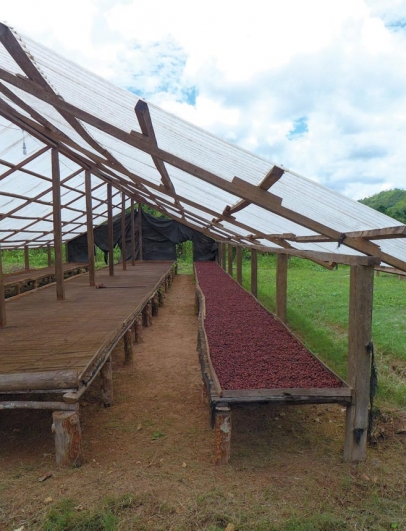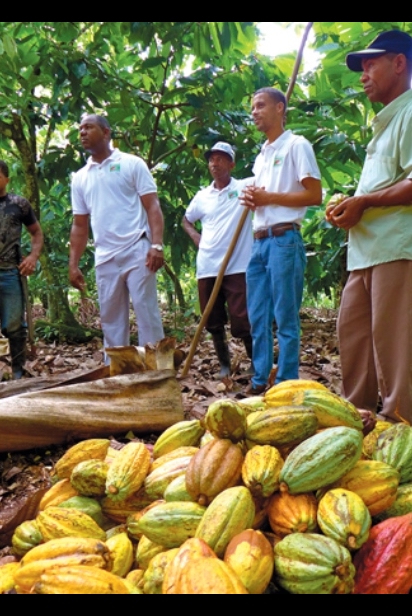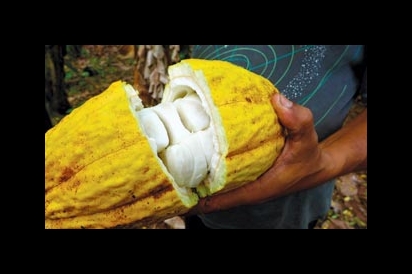Going Beyond the Bar: On the Darker Side of Chocolate, Fair Trade Finds a Sweet Spot
Pity the poor quartet of contributors to Edible Rhody who recently had the thankless (not!) job of tasting chocolate samples at Equal Exchange, a fair-trade importer of ethically sourced chocolate, coffee and tea, headquartered in West Bridgewater, Massachusetts, not far from the Rhode Island border. While surrounded by displays of the company’s colorfully packaged chocolate bars, milk and dark mini-chocolate pieces, bittersweet and semi-sweet chocolate chips, baking cocoa, hot chocolate mix and spicy hot cocoa mix, we set about the task of analyzing two types of dark chocolate, mysteriously called “P” and “E.”
One of us detected an aroma of cherries in the “P” sample, while another described it as “fudgy, rich and mouth-filling.” Sample “E” had a glossier surface, and melted in the mouth more quickly than “P.” It conjured intense vanilla and nut flavors, as well as a fruity yet slightly bitter aftertaste. Both chocolates made a loud, clean “snap” when broken in two, an indication, we would learn, that it had been well tempered, one of the processes involved in converting cacao beans into chocolate.
“It’s all about terroir,” said Cristina Liberati, grants projects coordinator at Equal Exchange, and the facilitator of the tasting. Equal Exchange sources its organically grown cacao from Panama, Ecuador—hence the “P” and “E” samples—the Dominican Republic and Peru. Even within each country of origin, she explained, small differences in climate and topography, not to mention processing techniques, affect the final character of the finished product—just as in winemaking.
“So few people even realize that chocolate comes from a tree,” she sighed.
In a wider sense, “terroir” can also pertain to the people who tend the ground where cacao grows. These small-scale farmers, situated in the equatorial areas where the cacao tree flourishes, have often received the short end of the stick when it comes to proper compensation and recognition of their work.
Let’s backtrack for a moment to some cacao basics. A finicky evergreen, native to Central and South America, the cacao tree produces reddish-brown, leathery, melon-shaped fruit, or pods, that grow directly from the tree trunk. Ripe pods are commercially harvested twice a year, at which time they are split open and their contents emptied. Inside the pod, the seeds, also known as cacao beans, and their surrounding pulp are fermented and dried in the sun, an essential step to developing flavor.
Fermented dried beans are shipped from the farm to a factory, generally located in the Northern Hemisphere. Further processing—roasting, cracking, winnowing, grinding, a step called conching and finally tempering—takes place in the week or so it takes to transform dried beans into wrapped chocolate bars.
The pre-Columbian Maya and Aztec of Yucatan and Guatemala cultivated the Criollo variety of cacao tree. They prepared a frothy hot chocolate drink from cacao beans, flavored with vanilla, chillis or other ingredients. Chocolate was considered ceremonial and serious; it was served at banquets, offered to the gods and used to anoint newborn children on the forehead, face, fingers and toes in a rite resembling baptism. Cacao became a major source of wealth to Aztec merchants.
Spanish explorers encountered chocolate on their early voyages to the New World in the 16th century. At first disgusted by the frothy dark beverage that was present at every Aztec festival, the conquistadores eventually came to enjoy it, and considered it an aphrodisiac.
Cacao beans are known to have reached the Old World by 1544, when a party of Kekchi Maya from Guatemala, led by Dominican friars, paid a visit to the future Philip II of Spain. By the 17th century, the Spanish court was known for its expertise in preparing chocolate drinks. Considered an expensive, exotic spice with medicinal attributes, hot chocolate was gradually introduced to the rest of Europe. It was embraced in Italy and France, and by 1675 chocolate houses sprang up in London, where they became fashionable meeting places.
As demand grew, Criollo began to be cultivated in Venezuela as well as Trinidad, Jamaica and other Caribbean islands. In the 17th century Spanish and Portuguese prospectors in Brazil encountered a distinct variety of cacao—now known as Forastero—growing wild. (Later, a third variety of cacao, Trinitario, a hybrid, emerged in Trinidad.) From Brazil, the Forastero seedlings were brought to islands off West Africa. By the early 20th century, cacao was being cultivated in Sri Lanka, Malaya, Java, Sumatra and New Guinea.
Today, the world produces nearly 3 million tons of cacao annually. Nearly 70% of it is grown in Ivory Coast, Ghana, Nigeria and Cameroon in West Africa. (Because of the Ebola outbreak, Ivory Coast—the world’s largest producer of cacao—has shut down its borders with Liberia and Guinea, thereby putting a crimp on the workforce needed from these countries to harvest cacao. Prices on chocolate futures have been seesawing.)
The vast majority of the world’s cacao is produced by small family farmers who live in isolated areas in the Southern Hemisphere. Like the sugar and coffee industries, which were originally rooted in slavery, chocolate, too, has had an unsavory past. After slavery was abolished in Brazil in the 1880s, chocolate companies began sourcing in Tanzania, where slavery still existed. Further abuses have persisted, including the use of child and forced labor on cacao farms in West Africa in the early 2000s, with corporations mostly turning a blind eye toward conditions and reform. They didn’t need to—the small-scale cacao farmers had no leverage with agribusiness.
“There’s a long chain between the farm and the chocolate bar,” explained Rodney North, public affairs manager at Equal Exchange. All sorts of middlemen, including harvesters, grinders, roasters, buyers, manufacturers and distributors have undercut growers’ earnings along the supply chain, leaving them to bear the greatest environmental risks, such as droughts and blights, with the lowest profits.
The fair-trade movement set out to correct some of these imbalances in the 1940s in Europe, when church-based organizations began importing village handcrafts for sale in Europe and North America. The movement eventually evolved into a third-party certification system that was set up to verify that traders and small farmers were operating under a set of agreed-upon principles. Its mandate? “Based on the idea that we can harness the power of global markets, gain access to markets, invest in communities and business, we enable you, the consumer, to make a difference with your dollar,” said Jenna Larson, senior communications manager at the certifying organization Fair Trade USA.
Equal Exchange took an entirely different approach to changing the global food system. When it was founded in 1986, well before “socially responsible business” became a buzz phrase, its goal was to work directly with pre-established, self-certifying farmer co-ops, to support their empowerment in the marketplace and bring consumers a better product, according to co-founder Rink Dickinson, a Providence resident. (As a learning tool, Equal Exchange labels each of its chocolate bars with the name and photo of its grower, his location and a profile of the co-op to which he belongs.)
“We thought it was better for farmer co-ops to be controlled by farmers, rather than North American nonprofits,” said Dickinson. “It was a radical idea back then. Everyone was telling us to do a regular business, and then make donations to worthy causes but we had a very supportive core investment group who made this idea of balancing the interests of farmers, customers and shareholders possible.”
True to its principles, Equal Exchange is a worker-owned cooperative, where every employee is also an equal owner, each with one vote and each eligible to serve on the company’s board.
The main point that Dickinson makes is that consumers have more influence than they realize in the marketplace. You can eat your chocolate, enjoying every single nuance of its flavor and texture, while supporting a more equitable—and delicious—global marketplace.
Photos courtesy of Equal Exchange. For more information on the international chocolate trade, visit EqualExchange.coop







